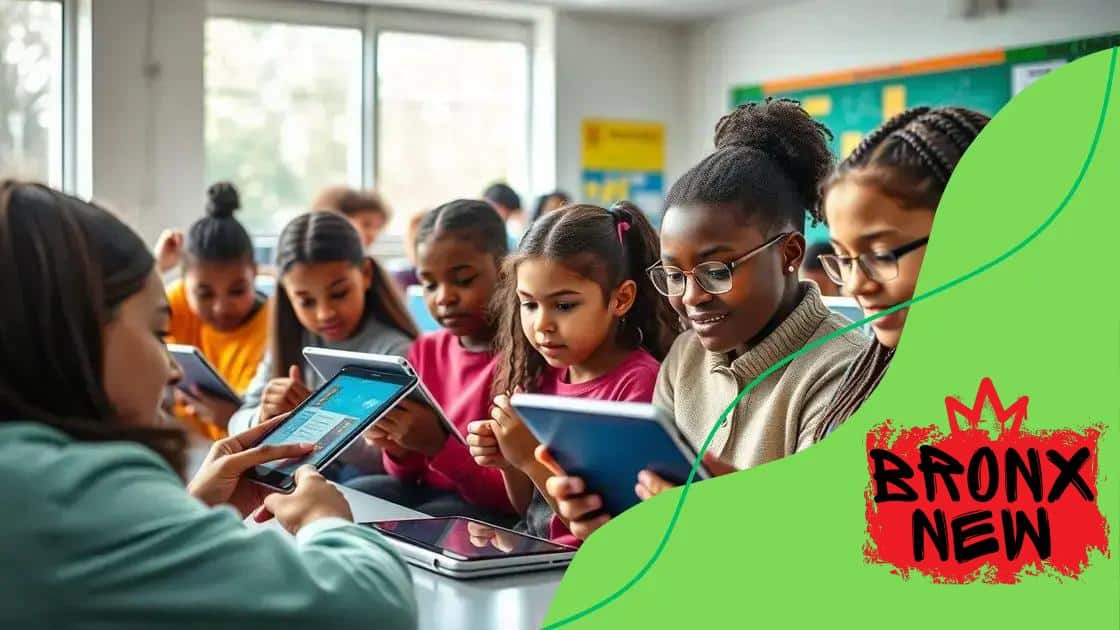AI tools for monitoring student progress: what’s next?

AI tools for monitoring student progress enhance personalized learning by providing data-driven insights, automating administrative tasks, and creating engaging educational experiences tailored to individual student needs.
AI tools for monitoring student progress are transforming how educators assess and support their students. But have you ever wondered how these technologies actually work? Let’s dive into the crucial aspects of using AI in education.
Key features of AI tools for tracking student progress
Understanding the key features of AI tools for tracking student progress can greatly enhance educational outcomes. These tools offer a range of functionalities tailored to meet the needs of students and educators alike.
Data Analytics Capabilities
AI tools excel in their ability to analyze large amounts of data efficiently. This allows teachers to:
- Quickly assess student performance
- Identify learning gaps
- Monitor progress over time
With these analytics, educators can make informed decisions about their teaching strategies, ensuring that all students receive the support they need.
User-Friendly Dashboards
Another significant feature is the intuitive dashboards that many AI tools provide. These dashboards allow teachers to:
- Visualize student progress easily
- Access real-time data on various metrics
- Customize their views based on specific needs
Such user-friendly interfaces make data interpretation straightforward and actionable.
Moreover, AI tools can generate reports that highlight trends and areas for improvement. Educators can share these reports with stakeholders, fostering a collaborative approach to student learning.
In addition to analytics, these tools can also offer personalized learning experiences by adapting to each student’s unique needs. This tailored approach not only boosts engagement but also helps students master subjects at their own pace.
Finally, the integration of AI tools with existing learning management systems (LMS) enhances their effectiveness. This seamless integration allows for:
- Streamlined workflows
- Improved communication among teachers, students, and parents
- Enhanced student engagement through interactive features
In conclusion, the key features of AI tools for tracking student progress include robust data analytics, user-friendly interfaces, personalized learning experiences, and seamless integration with LMS. Educators who leverage these features can better support their students in achieving academic success.
How AI improves personalized learning
AI improves personalized learning by catering to the unique needs of each student. This technology analyzes a student’s learning style, pace, and preferences to provide tailored educational experiences.
Adaptive Learning Systems
One major way AI enhances personalized learning is through adaptive learning systems. These systems:
- Adjust content based on student performance
- Identify strengths and weaknesses
- Provide instant feedback
By continuously adapting to the learner, these systems keep students engaged and motivated.
Personalized Learning Paths
AI tools can create personalized learning paths that fit individual students. These paths help educators:
- Develop customized lesson plans
- Focus on areas needing improvement
- Encourage student autonomy through choice
Students can progress at their own pace, leading to a deeper understanding of the material.
Moreover, AI helps teachers monitor progress efficiently. With data analytics, educators can gain insights into how students interact with the content. This allows them to make timely adjustments, providing support when it’s needed most.
Additionally, integrating AI into the classroom enhances collaboration among students. AI tools can group students with similar skills or challenges, fostering peer-to-peer learning. This environment encourages sharing ideas and building knowledge together.
Benefits of using AI for educators

The benefits of using AI for educators are vast and impactful. AI streamlines many processes, allowing teachers to focus more on their students and less on administrative tasks.
Time-Saving Automation
By automating routine tasks, AI helps educators save valuable time. For example, grading assignments and providing feedback can be done quickly through:
- AI-driven grading systems
- Automated report generation
- Scheduling tools for managing classes
This time-saving aspect allows teachers to dedicate more attention to actual teaching and student engagement.
Enhanced Data-Driven Insights
AI provides powerful data analysis capabilities, helping educators gain insights into student performance. This can lead to:
- Identifying trends in learning outcomes
- Tailoring instruction based on data
- Making informed decisions about curriculum reforms
Such insights empower teachers to adjust their strategies promptly to support their students effectively.
Moreover, AI tools facilitate collaboration between teachers, making it easier to share resources and strategies that work. Teachers can connect with each other through platforms that recommend best practices based on data analysis.
An additional benefit lies in the professional development opportunities that AI offers. Educators can access personalized training resources tailored to their needs and skill levels. This creates a culture of continuous improvement, enabling teachers to grow alongside their students.
Furthermore, AI can assist in identifying students who may need additional support. By analyzing performance data, educators can intervene early and provide targeted help, ensuring that no student is left behind.
Challenges in implementing AI tools in schools
Implementing AI tools in schools comes with its own set of challenges. While these technologies offer immense potential, obstacles can hinder their effective integration into the classroom.
Resistance to Change
One major challenge is resistance to change among educators and administrators. Some may feel hesitant about adopting new technologies due to:
- Fear of job displacement
- Lack of understanding of AI capabilities
- Concerns over replacing traditional teaching methods
This resistance can slow down the adoption of AI tools, preventing schools from reaping the benefits of innovation.
Training and Support
Another significant hurdle is the need for proper training and support. Educators require:
- Workshops to understand how to use AI tools
- Continuous professional development opportunities
- Access to resources and technical support
Without adequate training, teachers may struggle to utilize AI effectively, leading to underutilization of these tools in their classrooms.
Additionally, funding can be a barrier. Schools often face budget constraints that limit their ability to purchase advanced AI systems and the necessary infrastructure to support them. This lack of resources can hinder the implementation process and affect the quality of education.
Moreover, data privacy concerns are a significant issue. Implementing AI tools requires collecting and analyzing student data, which raises questions about:
- Data security
- Parental consent
- Compliance with regulations
Addressing these concerns is crucial to ensure that schools protect student information while leveraging technology. Lastly, the integration of AI tools must consider the diverse needs of students. Ensuring equity in access and use is essential, as not all students may benefit equally from AI-enhanced learning.
Future trends in AI education technology
The future of AI education technology holds exciting possibilities that can reshape the learning experience for students and educators alike. As technology continues to advance, we can expect significant changes in how education is delivered.
Personalized Learning Experiences
One major trend is the rise of even more personalized learning experiences. Future AI tools are likely to offer:
- In-depth analysis of individual learning styles
- Customized content tailored to student interests
- Real-time adjustments based on student feedback
These features will further enhance student engagement and motivation, allowing for a deeper understanding of the subject matter.
Integration of Virtual and Augmented Reality
Another trend is the integration of virtual and augmented reality with AI. This combination will enable immersive learning environments where students can:
- Explore historical sites in virtual field trips
- Interact with 3D models of complex concepts
- Participate in simulations that mimic real-life scenarios
Such advancements will create more engaging and effective learning experiences.
Moreover, AI is expected to play a crucial role in developing smart classrooms. These classrooms will utilize advanced technologies to:
- Optimize the physical learning environment
- Provide insights on student behavior and engagement
- Automatically adjust resources and tools as needed
This dynamic approach to learning will help educators tailor their teaching methods to better meet student needs.
Additionally, the use of AI in administrative tasks is anticipated to grow. Schools will increasingly rely on AI tools to:
- Automate scheduling and planning
- Manage student information securely
- Provide predictive analytics for resource allocation
This shift will allow educators to focus more on teaching and less on paperwork, ultimately improving the quality of education.
FAQ – Frequently Asked Questions about AI Tools in Education
How can AI tools improve student engagement?
AI tools personalize learning experiences, adapting to individual student needs, which boosts their motivation and interest in the material.
What challenges do educators face when implementing AI tools?
Educators often struggle with resistance to change, insufficient training, and concerns about data privacy when adopting AI technologies.
What role does data analysis play in AI education tools?
Data analysis helps educators track student performance, identify learning gaps, and tailor instruction for better outcomes.
Will AI replace teachers in the classroom?
No, AI is designed to support teachers by automating tasks and providing insights, allowing them to focus more on teaching and student interaction.





